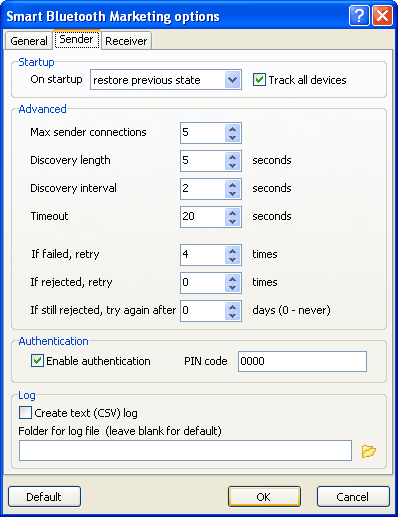Sender options

On startup - configure the initial state of the sender
Possible options
don't start sender - sender left in stopped state on program startup
start sender - sender is started on program startup
restore previous state - sender state is remembered on program exit and is restored on program startup
Track all devices - Check this box, if you wish to track devices which don't support receiving files through OBEX (headsets, printers, scanners, cameras, etc.). Anyway the sender will not try to contact them.
Advanced (don't modify these settings unless you are completely sure of what you are doing)
Max sender connections - Specify how many devices will be contacted simultaneously. For almost all bluetooth adapters maximum supported simultaneous connections are 7.
Discovery length - Specify period during which Smart Bluetooth Marketing will be searching for devices in range.
Discovery interval - Specify timeout between the searches
Timeout - Specify period to wait for connection before giving up.
If failed, retry - Specify how many times retry to connect in case of failure (timeout, device disappeared from the range, other hardware failures).
If rejected, retry - Specify how many times retry to connect in case user rejects your message. It is strongly recommended not to set this value greater than 0.
If still rejected, try again after - In case user rejects your message, try again after this period of time (zero means never).
Enable authentication - Some older devices may require authentication to connect.
PIN code - Specify PIN code, when trying to connect to devices with authentication.
Log - Create sender's log in the text (CSV) format. The log is created in the selected directory. (The default is "c:\documents and settings\YOUR_USERNAME\Application Data\SmartBluetoothMarketing\" on Windows XP and "c:\users\YOUR_USERNAME\AppData\Roaming\SmartBluetoothMarketing\" on Windows Vista and Windows 7.
The log file (sender_log.txt) contains the following fields:
1. Unique ID of the event.
2. Date and time of the event
3. Unique ID of the marketing campaign
4. Title of the marketing campaign
5. Hardware address of the remote device
6. Name of the remote device
7. Type of the remote device
8. Manufacturer of the remote device
9. Status (possible values: "OK", "Ignored", "Rejected")
As the log file is constantly updating, be sure to open it in read-only mode with the external applications.
